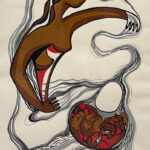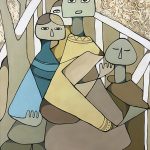Daphne Odjig : Centenary
September 28 to October 29, 2019Daphne Odjig‘s paintings, drawings and prints span over fifty years and on this centennial anniversary of the artist’s birth, Gallery Gevik is pleased to present a career-spanning retrospective and celebration, showcasing rare works from the 1960s to the 1990s. Opening Ceremony at 2:30 pm on September 28, 2019 by Dr. Elder Bob Phillips followed by a panel discussion on the Artist’s life and work with multi-disciplinary artist and curator Bonnie Devine, art historian & curator Dr. Elizabeth McLuhan, & Chief Curator of the McMichael Canadian Art Collection, Sarah Milroy.
The Spiritual World of the Medicine Man II, c. 1975
acrylic on board, 32" × 40" (SOLD)Daphne Odjig is one of Canada’s most celebrated and influential Indigenous artists. Her paintings, drawings and prints span over fifty years and on this centennial anniversary of the artist’s birth, Gallery Gevik is pleased to present a career-spanning retrospective and celebration, showcasing rare works from the 1960s when Daphne first began to explore her Aboriginal identity through to the more transcendental paintings of the 1990s.
Born in 1919 on Manitoulin Island’s Wikwemikong First Nation, of Odawa, Potawatomi and English heritage, Odjig first learned about art-making from her grandfather, Jonas Odjig, a tombstone carver who taught her to draw and paint. Odjig’s style underwent several developments through the decades, mixing traditional Aboriginal styles and imagery with Cubist and Surrealist influences. Odjig’s work is defined by curving contours, strong outlining, overlapping shapes and an unsurpassed sense of colour. In describing the inspiration for her work, Odjig has said that she “feels all aspects of life, and believes that it is all to be shared and recounted. It may not sound right to celebrate [death], but it is just as important to me to recognize loss and turmoil [as it is] to share joy.” Throughout her life, Odjig’s work has addressed issues of colonization, the displacement of Aboriginal peoples, and the status of Aboriginal women and children, bringing Aboriginal political issues to the forefront of contemporary art practices and theory.
In 1973, she was a founding member of the Professional Native Indian Artists Association — otherwise known as the Indian Group of Seven — which included Jackson Beardy, Eddy Cobiness, Alex Janvier, Norval Morrisseau, Carl Ray, and Joseph Sanchez. In Winnipeg a year later, she opened the first art gallery in Canada to represent First Nations artists exclusively. Odjig has received many awards and forms of recognition for her work, including the Order of Canada and the Governor General’s Award in Visual and Media Arts. Her work can be found in public and private collections around the world, including the National Gallery of Canada, the McMichael Canadian Art Collection, the Art Gallery of Ontario, the Sequoyah National Research Center in Arkansas and the Government of Israel. Her work has been part of more than 30 solo and 50 group exhibitions around the world — including a 2009 solo exhibition at the National Gallery of Canada — and in 2011, Canada Post featured three of her paintings on a series of postage stamps.
Daphne was a source of inspiration to many, and her advice was simple: “just be yourself and let your imagination, thoughts, beliefs, views, visions — or whatever inspires you — be seen. Be vulnerable, and share what is inside you.” Daphne died in 2016 at the age 96 in Kelowna, British Columbia.











